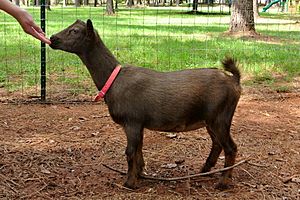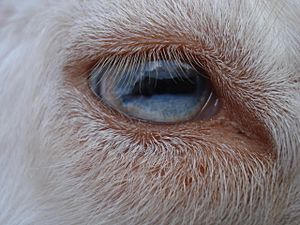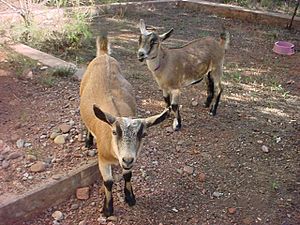Nigerian Dwarf goat facts for kids

A 6-month-old doe
|
|
| Conservation status |
|
|---|---|
| Country of origin | United States |
| Standard |
|
| Use |
|
| Traits | |
| Height |
|
| Wool color | any color |
| Horn status | horned or hornless |
|
|
The Nigerian Dwarf is a small and friendly goat breed from the United States. It's known for being a "dwarf" goat, meaning it's much smaller than other goat breeds. This breed comes from the West African Dwarf goats, which were brought to the U.S. from West Africa.
Contents
History of Nigerian Dwarf Goats
How Nigerian Dwarfs Came to Be
Between the 1930s and 1960s, many small goats from West Africa were brought to the United States. They were mostly kept in zoos for people to see. The Nigerian Dwarf goat developed from these African goats.
Unlike their stocky West African relatives, Nigerian Dwarfs were bred to look like tiny dairy goats. At first, people raised them as show animals and pets. Breeders chose goats that looked good and were gentle.
Later, people discovered these small goats were great for producing milk on small farms. So, some breeding efforts focused on making them even better at giving milk. A special record book for the breed was started in 1980.
Growth and Recognition
The number of Nigerian Dwarf goats grew quickly. By 2002, nearly 7,000 were officially registered. The American Dairy Goat Association officially recognized the breed in 2005.
The Nigerian Dwarf was once on a special list of "recovering" breeds by the Livestock Conservancy. This meant their numbers were low but getting better. However, they were removed from this list in 2013 because their population had grown so much!
In the 1990s, a new breed called the Nigora was created. This happened by mixing Nigerian Dwarf goats with Angora goats and other breeds known for their soft hair.
Characteristics of Nigerian Dwarf Goats
The Nigerian Dwarf is a small goat, but it has the same body shape as larger dairy goats. They can have horns, or they can be born without them. Their coat is fine and short, and it can be any color or even multicolored. Common colors include gold, chocolate, and black, often with white spots.
Their face can be flat or slightly curved inwards. Their ears stand upright. On average, they weigh about 35 kilograms (77 pounds). Males can be up to 60 centimeters (24 inches) tall, and females are a little shorter. Goats bred for milk might be a bit larger than those kept as pets or for shows.
Reproduction and Life Cycle
Nigerian Dwarf goats grow up quickly. Young males can start breeding around three months old. Females can start when they are about seven or eight months old.
A female goat is pregnant for about 145 to 153 days. They often have twins, and it's not unusual for them to have triplets or even quadruplets! These goats usually live for 8 to 12 years.
Uses of Nigerian Dwarf Goats
As you learned, Nigerian Dwarf goats were first bred for shows and as pets. But they also became very popular for their milk.
Milk Production
Dairy Nigerian Dwarf goats can produce about 340 kilograms (750 pounds) of milk each year. The most milk ever recorded from one goat in a year was 782 kilograms (1,724 pounds)! They usually give milk for about ten months after having babies.
Their milk is special because it's very high in butterfat and protein. On average, it has 6.5% butterfat and 3.9% protein. This rich milk is excellent for making delicious cheese and butter.



